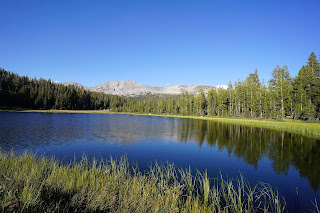Dale Matson
The background on my response can be found here: http://www.fresnobee.com/news/local/article96900372.html
There is recent advocacy to designate the Sierra National
Forest as a “Monument”. Deanna Wulff has been the spokesperson behind this idea
but the Sierra Club is also involved and favors monument status. The Fresno Bee
is also sympathetic to the idea and provided a rather biased platform for Ms
Wulff in their article. I sent a 200-word letter to the editor opposing the
monument status for the Sierra National Forest and it was not printed so I now
am expanding on my concerns here.
Let me begin by correcting some inaccuracies in the article.
There is closer to 50 miles of the PCT not 20 miles contained in the Sierra
National Forest. The endangered sheep are the Sierra Nevada Bighorn Sheep not
the California Bighorn Sheep. Additionally, The map shown in the Bee article
lists only two wilderness areas in the Sierra National Forest John Muir and
Ansel Adams Wilderness. There is also the Dinkey Lakes and the Kaiser
Wilderness.
First there is the politics of the decision. There has
always been a rivalry between the U.S. Forest Service that views forests as
resources to be harvested and sources of recreation, and the National Park
Service with its “hands off” limited access perspectives. Advocates of the monument status would really
rather see the National Park Service manage the forest and monument status
could change federal oversight to the National Park Service. One commenter
referred to them as the “Gold Standard”. Ask folks who live near Yellowstone
Park who lived through one of the worst forest fires in park history because of
the “let burn” policy that got out of control by the National Park Service.
Second, Most of the Sierra National Forest is designated
“Wilderness”. The spirit of the Wilderness act of 1964 was to “Leave No Trace”.
I don’t know what one could accomplish in the way of preservation by adding
National Monument status to the Sierra National Forest. One more layer of
“protection” only adds to the confusion. As someone who has traveled thousands
of miles on trails hiking and backpacking, I have had to reserve wilderness permits
to travel on those trails if I intended to stay overnight. Access is limited on
each trailhead in the Sierra National Forest each day for those wishing to stay
overnight. The trails in the Sierra National Forest are disappearing. We need
more access not less access.
Third, in the
article Kevin Elliot the supervisor for the Sequoia National Forest and
Monument stated, ““Some folks thought by designating the monument, surely that
will bring some additional funding to address those objects of interest, and that
didn’t happen and I don’t see that happening, to be honest,” Elliott says.
Fourth, I don’t see controlled burns as the answer to
thinning forests.
As a Central Valley Resident, we already breathe some of the
worst air in the U.S.
The Bee is portraying this as a “grassroots campaign” when
in fact it is strongly supported by the Sierra Club which recently had one of
it’s founding members Joseph LeConte name removed from the LeConte Memorial in
Yosemite because he had made racist remarks. Are they also going to propose
that the topographical maps have all references to his name removed also?
Ms Wulff is well intended but misguided in thinking that
more protection will not mean less access. It is the same mentality that
advocated for “protected’ status for the mountain lion when the lion was not an
endangered or even threatened species. Now the mountain lion, an apex predator,
with no population control is expanding beyond traditional boundaries and what
is referred to, as “human encroachment” is actually mountain lion encroachment.
The mountain lion has become the single biggest threat to the reestablishment
of the truly endangered Sierra Nevada Bighorn Sheep in their historic Sierra
range.
The biggest argument against making the Sierra National
Forest a monument is the example of the Sequoia National Monument where nothing
really changed for the better.








































































